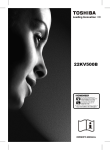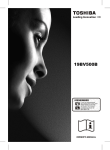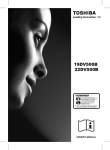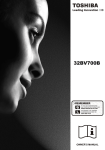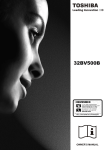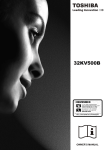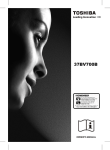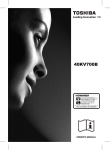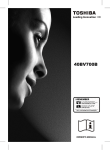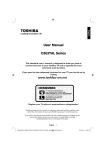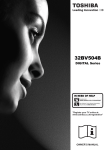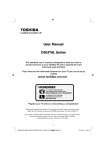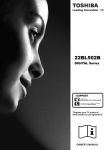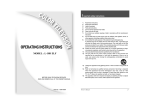Download Toshiba 22BV500B LCD TV
Transcript
22BV500B OWNER’S MANUAL 〰彍䈴㕟孇䉝彃佖䕒弨䥂彉乔䕒久吩弱〰㘸㐳 ㄴ⁍慹ﵳ′〱〠䍵浡‰㠺㔳㨱 Contents Safety Precautions ................................................. 2 Air Circulation ..................................................... 2 Heat Damage...................................................... 2 Mains Supply ...................................................... 2 Warning ............................................................. 2 Do ....................................................................... 2 Do not ................................................................. 2 Installation and Important Information .................... 3 Exclusion Clause ................................................ 3 Digital Switchover ................................................... 4 Inserting Batteries and Effective Range of the Remote Control................................................... 5 To Connect an HDMI Device .............................. 7 To Connect a DVI Device.................................... 7 To Connect a Computer ...................................... 8 To Connect a USB Disk ...................................... 8 USB Memory Connection ................................... 8 Switching on ....................................................... 9 Using the Remote Control .................................. 9 Using the Controls and Connections on the TV.. 9 Auto Tuning....................................................... 10 Digital Manual Tuning ........................................11 Analogue Manual Tuning ...................................11 APS (Automatic Programming System)............ 12 Sorting Programme Positions - Analogue ......... 12 Stereo and Bilingual Transmissions.................. 13 Viewing Channel List ........................................ 13 Moving a Channel ............................................. 13 Deleting a Channel ........................................... 13 Renaming a Channel ........................................ 14 Locking a Channel ............................................ 14 Viewing Info Banner.......................................... 14 Electronic Programme Guide............................ 14 Programme Searching ...................................... 15 Displaying Subtitles .......................................... 15 Language Settings ............................................ 15 Preferred ........................................................... 15 Current .......................................................... 15 Viewing Parental Control Menu ........................ 16 Menu Lock ........................................................ 16 Set PIN ............................................................. 16 Viewing Configuration Menu ............................. 17 Hard of Hearing (* for EU countries only) ......... 17 Controlling Favourite Mode............................... 17 Channel List Mode ............................................ 17 Scan Encrypted ............................................... 17 Receiver Upgrade ............................................. 17 Note on Analogue switch-off ............................. 17 Audio Description (optional).............................. 18 Standby Search (*) ........................................... 18 Viewing Main Menu .......................................... 18 Selecting Programme Positions........................ 18 Input Selection .................................................. 18 Controlling Volume and Muting Sound ............. 19 Equalizer Settings ............................................. 19 Balance ............................................................. 19 Headphone Volume .......................................... 19 Sound Mode .................................................... 19 AVL ................................................................... 19 Picture Mode..................................................... 20 Picture Adjustments .......................................... 20 Colour Temperature .......................................... 20 Noise Reduction ............................................... 20 Film Mode ......................................................... 20 Game Mode ...................................................... 20 Picture Zoom .................................................... 20 Resetting Picture Settings ................................ 20 Child Lock ......................................................... 22 Default Zoom .................................................... 22 Blue Background .............................................. 22 Menu Background............................................. 22 Menu Timeout ................................................... 22 HDMI PC Full Mode (optional) .......................... 22 Full Mode (optional) .......................................... 22 Ext Out .............................................................. 22 Programme Timers - Digital Only...................... 23 Sleep Timer - Analogue .................................... 23 Conditional Access ........................................... 23 Manual Start ..................................................... 23 Auto Start .......................................................... 24 Playing MP3 Files ............................................. 24 Viewing JPG Files............................................. 24 Slideshow Feature ............................................ 25 To Close the Media Player ................................ 25 Autoposition ...................................................... 26 H Position ......................................................... 26 V Position.......................................................... 26 Dot Clock .......................................................... 26 Phase................................................................ 26 Dot Clock ...................................................... 26 PC Picture controls ........................................... 26 Digital Text and Interactive Services ................. 27 Using Digital Interactive Services ..................... 27 Analogue Text Services (if available) ................ 27 Using Button ............................................. 27 Acessing Sub-Pages ........................................ 27 Revealing Concealed Text ................................ 27 Holding a Page ................................................ 27 Enlarging the Text Display Size ........................ 27 Appendix A: PC Input Typical Display Modes....... 28 PIN Information ................................................ 28 Appendix B: AV and HDMI Signal Compatibility (Input Signal Types).............................................. 29 Appendix C: Supported File Formats for USB Mode..................................................................... 30 Specifications and Accessories ............................ 31 License Information .............................................. 32 English - 1 - 00_MB45_[GB]_3910UK_IDTV_NICKEL9_22740W_(IB_INTERNET)_10068436.indd 1 17.05.2010 16:53:32 Safety Precautions This equipment has been designed and manufactured to meet international safety standards but, like any electrical equipment, care must be taken to obtain the best results and for safety to be assured. Please read the points below for your own safety. They are of a general nature, intended to help with all electronic consumer products and some points may not apply to the goods you have just purchased. Air Circulation Do not Leave more than 10cm clearance around the television to allow adequate ventilation. This will prevent overheating and possible damage to the television. Dusty places should also be avoided. DON’T remove any fixed cover as this may expose dangerous voltages. Heat Damage Damage may occur if the television is left in direct sunlight or near a heater. Avoid places subject to extremely high temperatures or humidity, or locations where the temperature is likely to fall below 5°C (41°F). Mains Supply The set should be operated only from a 220-240 V AC 50 Hz outlet. DO ensure that the television is not standing on the mains lead. DO NOT cut off the mains plug from this equipment, this incorporates a special Radio Interference Filter, the removal of which will impair its performance. In the UK, the fuse fitted in this plug is approved by ASTA or BSI to BS1362. It should only be replaced by a correctly rated and approved type and the fuse cover must be refitted. IF IN DOUBT PLEASE CONSULT A COMPETENT ELECTRICIAN. Warning To prevent the spread of fire, keep candles or other open flames away from this product at all times. DON’T obstruct the ventilation openings of the equipment with items such as newspapers, tablecloths, curtains, etc. Overheating will cause damage and shorten the life of the equipment. DON’T allow electrical equipment to be exposed to dripping or splashing or objects filled with liquids, such as vases, to be placed on the equipment. DON’T place hot objects or naked flame sources, such as lighted candles or nightlights on, or close to equipment. High temperatures can melt plastic and lead to fires. DON’T use makeshift stands and NEVER fix legs with wood screws. To ensure complete safety, always fit the manufacturers’ approved stand, bracket or legs with the fixings provided according to the instructions. DON’T leave equipment switched on when it is unattended, unless it is specifically stated that it is designed for unattended operation or has a standby mode. Switch off by withdrawing the plug, make sure your family know how to do this. Special arrangements may need to be made for people with disabilities. DON’T continue to operate the equipment if you are in any doubt about it working normally, or it is damaged in any way switch off, withdraw the mains plug and consult your dealer. WARNING - excessive sound pressure from earphones or headphones can cause hearing loss. ABOVE ALL - NEVER let anyone, especially children, push or hit the screen, push anything into holes, slots or any other openings in the case. NEVER guess or take chances with electrical equipment of any kind - it is better to be safe than sorry. Do DO read the operating instructions before you attempt to use the equipment. THE MAINS PLUG IS USED AS A DISCONNECTING DEVICE AND THEREFORE SHOULD BE READILY OPERABLE. DO ensure that all electrical connections (including the mains plug, extension leads and interconnections between pieces of equipment) are properly made and in accordance with the manufacturers’ instructions. Switch off and withdraw the mains plug before making or changing connections. DO consult your dealer if you are ever in doubt about the installation, operation or safety of your equipment. DO be careful with glass panels or doors on equipment. English - 2 - 00_MB45_[GB]_3910UK_IDTV_NICKEL9_22740W_(IB_INTERNET)_10068436.indd 2 17.05.2010 16:53:33 Installation and Important Information Where to install P Clip Fixing Strap Fixing Strap Sturdy tie (as short as possible) ''P' Clip position on TV is dependent on model * Button and stand style is dependent on model. Locate the television away from direct sunlight and strong lights. Soft, indirect lighting is recommended for comfortable viewing. Use curtains or blinds to prevent direct sunlight falling on the screen. Place the TV on a stable, level surface that can support the weight of the TV. In order to maintain stability and prevent it falling over, secure the TV to a wall using a sturdy tie to the clip on the back of the TV. The LCD display panels are manufactured using an extremely high level of precision technology; however, sometimes some parts of the screen may be missing picture elements or have luminous spots. This is not a sign of a malfunction. Make sure the television is located in a position where it cannot be pushed or hit by objects, as pressure will break or damage the screen. Also, please be certain that small items cannot be inserted into slots or openings in the case. Cleaning the screen and cabinet… Turn off the power, and clean the screen and cabinet with a soft, dry cloth. We recommend that you do not use any proprietary polishes or solvents on the screen or cabinet as this may cause damage. Please take note The digital reception function of this television is only effective in the countries listed in the “Country” section of the “SETUP” menu. Depending on country/area, some of this television’s functions may not be available. Reception of future additional or modified services can not be guaranteed with this television. If stationary images generated by 4:3 broadcasts, text services, channel identification logos, computer displays, video games, on screen menus, etc. are left on the television screen for any length of time, they could become conspicuous. It is always advisable to reduce both the brightness and contrast settings. Very long, continuous use of the 4:3 picture on a 16:9 screen may result in some retention of the image at the 4:3 outlines. This is not a defect of the LCD TV and is not covered under the manufacturer’s warranty. Regular use of other size modes will prevent permanent retention. Exclusion Clause Toshiba shall under no circumstances be liable for loss and/or damage to the product caused by: i) fire; ii) earthquake; iii) accidental damage; iv) intentional misuse of the product; v) use of the product in improper conditions; vi) loss and/or damage caused to the product whilst in the possession of a third party; vii) any damage or loss caused as a result of the owner’s failure and/or neglect to follow the instructions set out in the owner’s manual; viii) any loss or damage caused directly as a result of misuse or malfunction of the product when used simultaneously with associated equipment; Furthermore, under no circumstances shall Toshiba be liable for any consequential loss and/or damage including but not limited to the following, loss of profit, interruption of business, the loss of recorded data whether caused during normal operation or misuse of the product. Note: A Toshiba wall bracket or stand, where available, must be used. English - 3 - 00_MB45_[GB]_3910UK_IDTV_NICKEL9_22740W_(IB_INTERNET)_10068436.indd 3 17.05.2010 16:53:33 Digital Switchover 8IFOEPFTTXJUDIPWFSIBQQFO ,FFQUIJTJNQPSUBOU JOGPSNBUJPOBCPVU IPXUPSFUVOF ZPVS57EVSJOHUIF EJHJUBM57TXJUDIPWFS $PQFMBOETXJUDIFTPO0DUPCFS 5IFFYBDUEBUFZPV TXJUDIEFQFOETPOUIF USBOTNJUUFSZPVBSF TFSWFECZ5PDIFDL XIFOZPVTXJUDI HPUP%JHJUBM6,µT QPTUDPEFDIFDLFSPO XXXEJHJUBMVLDPVL IFDLZPVS*57OFXT $ TFSWJDFPSMPPLBU5FMFUFYU QBHFUPTFFXIBU57 SFHJPOZPVµSFJO Television in the UK is going digital, bringing us all more choice and new services. Starting in late 2007 and ending in 2012, television services in the UK will go completely digital, TV region by TV region. Please see above to find out when your area switches to digital. Digital UK is the independent, non-profit organisation leading the process of digital TV switchover in the UK. Digital UK provides impartial information on what people need to do to prepare for the move to digital, and when they need to do it. How the switchover affects your TV equipment: Your new TV has a digital tuner built in, which means it is ready to receive the Freeview signal by simply plugging it into your aerial socket (check if you can get digital TV through your aerial now, or whether you’ll have to wait until switchover, at www.digitaluk.co.uk). When the TV switchover happens in your area, there are at least two occasions when you will need to re-tune your TV in order to continue receiving your existing TV channels, and also to pick up new ones, Digital UK, the body leading the digital TV switchover, will advise you when you need to re-tune during the switchover. completely retune the television and can be used to update the channel list. • Press MENU button on the remote control unit. • Select SETUP and then INSTALLATION option. Select Automatic Search. • A screen will appear warning that previous digital programmes and settings will be deleted. • You must allow the television to complete the search... • When the search is complete the Auto tuning screen will display the total number of service found. NOTE: Further detailed instructions on Auto tuning can be found in the TV owners manual. If you are missing channels, it may be that they are not available in your area, or that your aerial needs upgrading. If you have any further questions, please contact your equipment supplier or call Digital UK on 08456 50 50 50 or visit www.digitaluk.co.uk If you choose to connect your TV to satellite or cable with a digital box then it will not be affected by switchover, and you won’t need to re-tune. Keep this important information about how to re-tune your TV during the digitalTV switchover How to re-tune: As new services are broadcast it will be necessary to retune the television in order to view them. Auto tuning will English - 4 - 00_MB45_[GB]_3910UK_IDTV_NICKEL9_22740W_(IB_INTERNET)_10068436.indd 4 17.05.2010 16:53:34 The Remote Control Simple at-a-glance reference of your remote control. Standby mode Mono-Stereo / Dual I-II Image size Expand (in TXT mode) Digital Services Subtitle on/off SCREEN LANG PIP No function No function Green button 1 2 3 4 5 6 7 8 9 0 Teletext / Mix / PAT Return / Exit menu BACK MENU OK Navigation buttons EPG Programme guide Info Reveal (in TXT mode) AV / Source SOURCE V To change channels SUBTTL - FAV INFO ? Current language selection To select TV programme number To return to the previous programme Menu on/off OK / Confirm Freeze picture (in analoge TV mode) Hold (in TXT mode) Favourite mode Picture mode selection PRESETS V P SLEEP + Display sleep timer To alter the volume To mute the sound + TOSHIBA RC-3910 Inserting Batteries and Effective Range of the Remote Control Remove the back cover to reveal the battery compartment and make sure the batteries are inserted the right way round. Suitable battery types for this remote are AAA, IEC R03 1.5V. + + - Do not combine a used, old battery with a new one or mix battery types. Remove dead batteries immediately to prevent acid from leaking into the battery compartment. Dispose of them in a designated disposal area. Warning: Batteries must not be exposed to excessive heat such as sunshine, fire or the like. The performance of the remote control will deteriorate beyond a distance of five metres or outside an angle of 30 degrees from the centre of the television. If the operating range becomes reduced the batteries may need replacing. English - 5 - 00_MB45_[GB]_3910UK_IDTV_NICKEL9_22740W_(IB_INTERNET)_10068436.indd 5 17.05.2010 16:53:34 Connecting External Equipment Before connecting any external equipment, turn off the On/Off switch and remove the mains plug from the wall socket. COMMON INTERFACE The Common Interface is for a Conditional Access Module (CAM). USB Input Side Video Input PC/AV Audio Inputs Headphone Aerial Input HDMI HDMI Input Socket * a decoder could be Digital Satellite, Free to Air or any other compatible decoder. Coax.OUT PC VGA Input SCART decoder* TV Scart Socket Aerial cable............................................................... Connect the aerial to the socket on the rear of the television. SCART lead.............................................................. If you use a decoder* or a media recorder, it is essential that the scart cable is connected to the television. Before running first time installation, any connected devices to standy mode. The phono sockets located on the side of the TV will accept L and R audio signals. HDMI® (High-Definition Multimedia Interface) is for using with a DVD decoder or other equipment with digital audio and video output. It is designed for best performance with 1080i and 1080p high-definition video signals but will also accept and display VGA, 480i, 480p, 576i, 576p and 720p signals. PC format signals will also be displayed. NOTE: Although this television is able to connect to HDMI equipment, it is possible that some equipment may not operate correctly. A wide variety of external equipment can be connected to the television; therefore, the relevant owner’s manuals for all additional equipment must be referred to for exact instructions. If the television automatically switches over to monitor external equipment, return to normal television by pressing the desired programme position button. To recall external equipment, press SOURCE button to switch between sources. You can also connect YPbPr equipment to your TV but this connection can only be enabled by using YPbPr to PC cable (Cable is not supplied). To enable sound connection, use AUDIO IN located side of the TV. .When the connection is made, switch to YPbPr source. See, Input selection section. English - 6 - 00_MB45_[GB]_3910UK_IDTV_NICKEL9_22740W_(IB_INTERNET)_10068436.indd 6 17.05.2010 16:53:34 Connecting an HDMI® or DVI Device to the HDMI Input The HDMI input on your television receives digital audio and uncompressed digital video from an HDMI source device or uncompressed digital video from a DVI (Digital Visual Interface) source device. This input is designed to accept HDCP (High-Bandwidth Digital-Content Protection) programme material in digital form from EIA/CEA-861-D–compliant [1] consumer electronic devices (such as a set-top box or DVD player with HDMI or DVI output). To Connect a DVI Device Connect an HDMI-to-DVI adaptor cable (HDMI type A connector) to the HDMI terminal and audio cables to the PC/ Side AV/YPbPr sockets (see illustration). • The recommended HDMI-to-DVI adaptor cable length is 6.6 ft (2m). • An HDMI-to-DVI adaptor cable transfers video only. Separate analogue audio cables are required. NOTE: • Some early HDMI equipment may not work properly with your latest HDMI TV. • Supported Audio format: Linear PCM, sampling rate 32/44.1/48kHz. To Connect an HDMI Device HDMI Connect an HDMI cable (type A connector) to the HDMI terminal. For proper operation, it is recommended that you use an HDMI cable with the HDMI Logo ( ). • If your HDMI connection is capable of 1080p and/or your television is capable of refresh rates greater than 50Hz, you will need a Category 2 cable. Conventional HDMI/DVI cable may not work properly with this mode. HDMI Input Socket Audio cable for HDMI to television connection (not supplied) HDMI to DVI Adapter Cable (not supplied) • HDMI cable transfers both video and audio. Separate analogue audio cables are not required (see illustration). • To view the HDMI device video, press the SOURCE button to select HDMI. NOTE: HDMI HDMI Input Socket To ensure that the HDMI or DVI device is reset properly, it is recommended that you follow these procedures: • When turning on your electronic components, turn on the television first, and then the HDMI or DVI device. • When turning off your electronic components, turn off the HDMI or DVI device first, and then the television. HDMI device English - 7 - 00_MB45_[GB]_3910UK_IDTV_NICKEL9_22740W_(IB_INTERNET)_10068436.indd 7 17.05.2010 16:53:35 Connecting a Computer Connecting a USB Disk To Connect a Computer To Connect a USB Disk With either an RGB/PC or an HDMI connection, you can watch your computer’s display on the television and hear the sound from the television’s speakers. • You can connect a USB disk to your TV by using the USB input of the TV. This feature allows you to display/play music or photo files stored in a USB stick. When connecting a PC to the RGB/PC terminal on thetelevision, use an analogue RGB (15-pin) computer cable anda PC audio cable for the AUDIO socket. • It is possible that certain types of USB devices (e.g. MP3 Players) may not be compatible with this TV. • You may back up your files before making any connections to the TV set in order to avoid any possible data loss. Note that manufacturer will not be responsible for any file damage or data loss. • The TV supports only FAT32 disk formatting. NTFS format is not supported. If you connect a USB disk with NTFS format, “usb is unformatted” osd will be displayed. • Do not pull out USB module while playing a file. CAUTION: Quickly plugging and unplugging USB devices, is a very hazardous operation. Especially, do not repeatedly quickly plug and unplug the drive. This may cause physical damage to the USB player and especially the USB device Audio cable for PC to television connection (not supplied) RGB PC Cable (not supplied) itself. USB Memory Connection • Plug your USB device to the USB input of the TV. IMPORTANT: The TV supports only FAT32 disk formatting. NTFS format is not supported. SIDE VIEW USB MEMORY To use a PC, set the monitor output resolution on the PC before connecting it to the television. To display the optimum picture, use the PC setting feature. NOTE: • The PC audio input terminal on the television is shared with the YPbPr and Side AV input terminal. • Some PC models cannot be connected to this television. An adaptor is not needed for computers with a compatible mini D-sub15-pin terminal. • Depending on the DVD’s title and the specifications of the PC on which you are playing the DVD-Video, some scenes may be skipped or you may not be able to pause during multiangle scenes. English - 8 - 00_MB45_[GB]_3910UK_IDTV_NICKEL9_22740W_(IB_INTERNET)_10068436.indd 8 17.05.2010 16:53:38 Controlling the TV A wide variety of external equipment can be connected via the sockets located on the side of the television. Whilst all the necessary adjustments and controls for the television are made using the remote control, the buttons on the right side of the television may be used for some functions. Front View Side View Programme / Up/Down Volume / AV Selection Button Standby / On Standby LED Switching on Using the Remote Control If the standby LED is unlit, check that the mains plug is connected to the power and then the LED lights up white. Press the MENU button on the remote control to see the menus. Press the button on the right side of the television to switch the television on. In analogue TV mode the menu appears as a group of icons each for a menu option. Press the Left or Right button to select a topic. To put the television into Standby, press on the remote again. The picture In digital TV mode the menu appears as a list. Press the Up or Down button to select a topic. The active Standby LED may appear for a few moments when the TV is switched off. To use the options press the Up and Down buttons on the remote control to move up and down through them and OK, Left or Right buttons to select the required choice. Follow the on screen instructions. The functions of each menu are described in detail throughout the manual. control. To view the television, press may take a few seconds to appear. Note: A beeping sound will be heard when the buttons are pressed. This is normal operation, not a fault. For energy saving: Turning the television off at its mains supply, or un-plugging it, will cut energy use to nearly zero for all televisions. This is recommended when the television is not being used for a long time, e.g. when on holiday. Reducing the brightness of the screen will reduce energy use. Energy efficiency cuts energy consumption and thus saves money by reducing electricity bills. Using the Controls and Connections on the TV • Press “+/-” buttons to increase or decrease volume, so a volume level scale (slider) will be displayed on the screen. • Main menu OSD cannot be displayed via control buttons. “+/-” buttons will function as volume up/down as default. Even if you set other functions for these buttons, “+/-” buttons will perform as default after a short while. NOTE: Putting the television into standby mode, will reduce energy consumption, but will still draw some power. • Press P/V/AV button once and then use “+/-” buttons to Please always refer to the owner’s manual of the equipment to be connected for full details. • Hold the “P/V/AV” button, source OSD will be displayed. NOTE: The USB socket has limited functionality, and Toshiba can take no responsibility for damage to other connected equipment. select the next or previous programme. • Use “+/-” buttons to select the desired source. English - 9 - 00_MB45_[GB]_3910UK_IDTV_NICKEL9_22740W_(IB_INTERNET)_10068436.indd 9 17.05.2010 16:53:40 Initial Installation - Digital & Analogue Before switching on the television put your decoder and media recorder to Standby if they are connected and ensure the aerial is connected to your television. To set up the television use the buttons on the remote control as detailed on page 4. 1. Connect the mains plug and switch the TV into standby using the side On/Off switch. Press any numbered or standby button on the remote control, then the language selection menu will be displayed. This screen will appear the first time that the television is switched on and each time the television is reset. 2. By pressing the Up or Down buttons highlight the language you want to set and press OK button. Afterwards,the following message will be displayed on the screen: 3. Select Yes by using Left or Right buttons and press OK to continue. The Auto tuning screen will appear and the television will start to search for available stations. The progress bar will move along the line. You must allow the television to complete the search. 4. After Automatic Search is completed, the following message asking for analogue channel search appears on the screen. Select Yes by using Left or Right buttons and press OK to continue. 5. Select your Country, Language and Text language by using navigation buttons. Press OK or RED button to continue. To cancel, press the BLUE button. Note: • For proper functioning of digital teletext in DTV mode, you should set country as UK in analogue AUTO Programme (for UK broadcasts only). • Do not turn off the TV while initializing first time installation. • Select the Installation from the Setup menu by using Up or Down buttons. Press OK and Installation menu will be displayed. • Select Automatic Channel Scan from the Installation menu by using Up or Down buttons and press OK. A screen will appear warning that previous digital programmes and settings will be deleted. Select Yes and press OK to continue with the Auto tuning. • The television will start to search for all available stations. You must allow the television to complete the search. When the search is complete the Auto tuning screen will display the total number of services found. • After search is completed for digital channels, a message asking whether to search for analogue channels appears on the screen: Auto Tuning As new services are broadcast, it will be necessary to re-tune the television in order to view them. Auto Tuning will completely re-tune the television and can be used to update the channel list. It is recommended that Auto Tuning is run periodically to ensure that all new services are added. All current channels and settings, i.e. locked channels, will be lost. • Select the SETUP from the main menu by using Up or Down buttons. Press OK and Setup menu will be displayed. • Press the OK button to search for analogue channels. The following menu appears on the screen for analogue channel search: English - 10 - 00_MB45_[GB]_3910UK_IDTV_NICKEL9_22740W_(IB_INTERNET)_10068436.indd 10 17.05.2010 16:53:40 Auto Tuning continued, Manual Tuning The television can be tuned-in manually using Manual Tuning feature. Analogue Manual Tuning The television can be tuned-in manually. For example: if the television cannot be connected to a media recorder/ decoder with a SCART lead or to tune-in a station on another System. To allocate a programme position on the television for a decoder and media recorder: turn the decoder on, insert a pre-recorded film into the media recorder and press PLAY, then manually tune. • Press MENU and using the Left or Right button select Install menu. • Select your Country, Language and Text language by using the navigation buttons. Press OK or RED button to continue. To cancel, press BLUE button. The following menu will be displayed during the automatic tuning: • After APS is finalized, the programme table will appear on the screen. In the programme table you will see the programme numbers and names assigned to the programmes. Digital Manual Tuning The feature is available for service engineers or can be used for direct channel entry if the multiplex channel is known. • Select Channel Search from the Installation menu and press OK. • Using the Down button select Program and key in the programme position to be tuned with the number buttons, we suggest Programme 0 for a media recorder. • Use the Down button to select Search then press the Left or Right button to search. The television will begin searching for channels. • Each signal will show on the television, if it is not your media recorder press the Left or Right button to restart the search. • When your media recorder signal is found, save the selection by pressing the Down button until Store is highlighted, then press the Left/Right or OK button to save. • Repeat for each programme position to be tuned then press BACK to finish. Note: Press SOURCE button to select between TV or DTV. • Enter the multiplex number using the numeric buttons. The television will automatically search for that multiplex. When the multiplex is found any channels not currently on the programme list will be added and the programme information at the top of the screen will be updated. • Repeat as necessary. Note: Press SOURCE button to switch between TV/DTV. English - 11 - 00_MB45_[GB]_3910UK_IDTV_NICKEL9_22740W_(IB_INTERNET)_10068436.indd 11 17.05.2010 16:53:40 Analogue APS and Programme Sorting Before switching on the television put your decoder and media recorder to Standby if they are connected and ensure the aerial is connected to your television. APS (Automatic Programming System) When the APS feature is selected all channels and settings will be lost, the television will return to factory settings and then re-tune. • Press MENU and using the Left or Right button select Program Table tab. You must allow the television to complete the search. • When the search is complete the television will automatically select programme position 1. This may not be a clear picture or the signal may be weak, so the station order can be changed using program table which will appear on the screen. • Press BACK to finish. Sorting Programme Positions - Analogue • Channels may be moved and saved to the position of your choice. • Select Programme Table tab from the main analogue TV menu. • With the list of channels showing, use navigation buttons to highlight the channel you want to move and press GREEN button. The selected channel will be highlighted with a frame. • Use navigation buttons move through the list to your preferred position. As you do so, the other channels will move to make room. • When finished, press GREEN button to save your move. • The Program screen will appear on the screen. Press the BLUE button to start APS. • Press the Left or Right button to set the country. • Press the BLUE button to cancel APS or the RED or OK button to start. English - 12 - 00_MB45_[GB]_3910UK_IDTV_NICKEL9_22740W_(IB_INTERNET)_10068436.indd 12 17.05.2010 16:53:40 Stereo and Bilingual Transmissions and Channel List Stereo and Bilingual Transmissions For ATV programmes If stereo or dual language broadcasts are transmitted, the word Stereo or Dual will appear on the screen each time positions are changed, disappearing after a few seconds. If the broadcast is not in stereo, the word Mono will appear. Stereo… Press LANG. to select Stereo or Mono. Bilingual… Bilingual transmissions are rare. If they are transmitted, the word Dual will be displayed. Choose the required programme number, and if the word Dual appears, press LANG. to select Dual 1, Dual 2 or Mono. Moving a Channel • Highlight the desired channel by using Up or Down buttons. • Select Move option in the channel list and press OK button. • Edit Number screen will be displayed. Enter the desired channel number by using the numeric buttons on the remote control. If there is a previously stored channel on that number, a warning screen will be displayed. Select Yes if you want to move the channel and press OK. For DTV Programmes To view current language and for changing to an alternative language (if available), press LANG. button. Available options will be listed. Viewing Channel List The channel order may be changed to suit your personal preference. • Select Channel List from the main DTV menu and press OK. • Press OK button to process. Selected channel is now moved. Deleting a Channel • Select the channel that you want to delete and select Delete option. Press OK button to continue. • A warning screen will appear. Select Yes to delete, select No to cancel. Press OK button to continue. • Press Up or Down button for selecting a channel. You can press RED or GREEN button to move page up or page down. • To watch a specific channel, highlight it by using Up or Down buttons. Afterwards highlight Select tab by using Left or Right buttons. Press OK button. English - 13 - 00_MB45_[GB]_3910UK_IDTV_NICKEL9_22740W_(IB_INTERNET)_10068436.indd 13 17.05.2010 16:53:40 Renaming a Channel and Viewing Info Banner and Programme Locking EPG Renaming a Channel Viewing Info Banner • Select the channel that you want to rename and select Edit Name option. Press OK button to continue. • Press INFO button the information screen will appear giving details of the channel and programme currently being viewed. • Whenever you change channel, the TV displays the broadcast picture along with an information banner at the bottom of the screen (available only in DTV mode). This will remain on the screen for a few seconds. • Pressing Left or Right button moves to the previous/next character. Pressing Up or Down button changes the current character. Pressing the numeric buttons ‘0...9’ replaces the highlighted character with the characters printed above the button one by one as the button is pressed. • When finished, press OK button to save. Press MENU to cancel. Locking a Channel You can press GREEN button to tag/untag all channels; YELLOW button to tag/untag a single channel. • If the selected channel is locked, you must enter the correct four numeric code to view the channel. “Enter PIN” will be displayed on the screen in such a case: • Enter the PIN number to continue. Electronic Programme Guide • Select the on-screen guide by pressing EPG, the guide screen will appear highlighting details of the channel and programme currently being viewed. This may take a few moments to appear. • Select the channel that you want to lock by using Up or Down buttons. • Select Lock option by using Left or Right buttons. Press OK button to continue. • You will be asked to enter parental control PIN. Enter the PIN number. Note: Default PIN is set to 0000. • Press OK button when the desired channel is highlighted to lock/unlock the channel. Lock symbol will be displayed next to the selected channel. • For information on a highlighted programme, press INFO button. • For details of other programmes currently available, press RED or GREEN to scroll up and down the list. As channels are selected, details of the programme currently being broadcast will appear. • To set the timer for a selected programme, press the OK button to select Timers menu. • Press YELLOW or BLUE for advancing to next or previous day. (SWAP) button to jump to the current • Press broadcast. English - 14 - 00_MB45_[GB]_3910UK_IDTV_NICKEL9_22740W_(IB_INTERNET)_10068436.indd 14 17.05.2010 16:53:40 Programme Searching, Displaying Subtitles and Language Settings Programme Searching Preferred From the guide screen, you can use search feature. • Press “0” button on the remote control to view Guide Search menu. Using this feature, you can search the programme guide database in accordance with the genre selected or with name match. Displaying Subtitles In digital mode, this feature will show subtitles on the screen in the selected language provided they are being broadcast. • Press SUBTTL button to activate available subtitles. • Press SUBTTL button again to turn off subtitles. These settings will be used if available. Otherwise the current settings will be used. Audio: by pressing Left or Right keys change the audio language. Subtitle: alter the subtitle language with Left or Right keys. The chosen language will be seen in subtitles. Movie Subtitle: In order to display subtitles properly, use this setting to select a movie subtitle language. By pressing Left or Right button, select the desired language option. Guide: By pressing Left or Right buttons change the guide language. Note: • If subtitles are on and a language option is set, pressing the “ ” button causes the following warning message (** for UK only): Current Audio: if audio language is supported change the audio language by pressing Left or Right buttons Subtitle: if subtitle is backed up, alter the subtitle language with Left or Right buttons. The chosen language will be seen in subtitles. Language Settings Using this menu you can adjust the preferred language settings. • Select Language from Setup menu and press OK to view this menu. Press the BACK button on the remote control to exit. English - 15 - 00_MB45_[GB]_3910UK_IDTV_NICKEL9_22740W_(IB_INTERNET)_10068436.indd 15 17.05.2010 16:53:41 Digital Settings - Parental Control, Menu Lock, Set PIN You can view or set parental preferences of your TV. Viewing Parental Control Menu Menu Lock • While in DTV mode, press MENU to view main menu. Select Setup from the list and press OK button. In menu lock you can set locking for all menus, or the Installation Menu to restrict access to these menus. If the menu lock is disabled, there will be free access to the menu system. • Use Up or Down buttons to go to Menu Lock option. Use Left or Right buttons to choose Menu Lock Mode. DISABLED : All menus are unlocked. ALL MENUS : All Menus are accessible only with the correct lock key. So the user cannot add, delete, rename, channels, cannot set timers. • Select Configuration by using Up or Down button and press OK. • Select Parental Control by using Up or Down button and press OK. INSTALLATION MENU: Installation menu is locked.So the user can’t add channels. Changes will be updated after exiting ‘Configuration Menu’. Set PIN • A dialogue box asking for the lock key will be displayed. The default key is set to 0000. Enter thePIN. • Use Up or Down buttons to select Set PIN option. Press OK to display the Set PIN window. • If it is incorrect, “Wrong Pin” OSD will be displayed. If it is correct, the Parental Control menu will be displayed: • Use numeric buttons to enter new pin number. You will need to input your new pin a second time for verification purposes. • After typing correct PIN numbers, PIN number will be changed. Note: The factory default pin number is 0000, if you change the pin number make sure you write it down and keep it safe. English - 16 - 00_MB45_[GB]_3910UK_IDTV_NICKEL9_22740W_(IB_INTERNET)_10068436.indd 16 17.05.2010 16:53:41 Digital Settings - Configuration You can configure DTV settings of your TV by using digital Configuration menu. Viewing Configuration Menu Scan Encrypted You can configure the settings of your TV. Select Configuration from Setup menu and press OK to view this menu. Press the BACK button on the remote control to exit. When this setting is on, search process will locate the encrypted channels as well. If it is set as OFF manually, encrypted channels will not be located while in automatic search or manual search. Scan Encrypted Channel feature will always be ON after performing first time installation. • In the CONFIGURATION menu, use Up or Down buttons to select Scan Encrypted. • Press Left or Right button to set this function as On or Off. Receiver Upgrade This feature helps to keep your TV updated. It works automatically and searches for new information when available. Note that this setting is inactive to be modified. Hard of Hearing (* for EU countries only) If the broadcaster enables any special signal concerning the audio, you can set this setting as On to receive such signals. • Use Up or Down button to select Hard of Hearing and then press Left or Right button to set this setting as On or Off. Controlling Favourite Mode • Please ensure that the TV is set to standby mode. The TV automatically goes to active standby mode at 3.00 A.M. each day and searches for any new information which may be broadcasted and will download this to your receiver automatically. This operation will normally take approximately 30 minutes. Note: Your TV may start in First Time Installation mode after software update. Note on Analogue switch-off Use this function to enable or disable favourite mode. • Press Left or Right button to set this function as on or off. Channel List Mode You can set a viewing type for channel list using this setting. • In the CONFIGURATION menu, use Up or Down buttons to select Channel List option. This is a digital television which is integrated to allow the use of both digital and analogue services. However, during the lifetime of this set it is very likely that analogue services will be switched off to allow for more new digital services. This ‘switch-off’ will happen in a number of phases, which will be advertised in your area well in advance. It is recommended that at each phase the television is re-tuned to ensure that existing and new digital services can be viewed without disruption. • Press Left or Right button to set this function to TV Only, Radio Only, Text Only or Show All. English - 17 - 00_MB45_[GB]_3910UK_IDTV_NICKEL9_22740W_(IB_INTERNET)_10068436.indd 17 17.05.2010 16:53:41 Digital Settings Configuration continued General Controls Some of the main controls of your TV are as the following. Audio Description (optional) Viewing Main Menu Audio description refers to an additional narration track for blind and visually impaired viewers of visual media, including television and movies. The description narrator talks through the presentation, describing what is happening on the screen during the natural pauses in the audio (and sometimes during dialogue, if deemed necessary). You can use this feature, only if the broadcaster supports that additional narration track. • Press “ ”/ “ ” buttons on the TV at the same time to view main menu. • In the configuration menu, highlight Audio Description by pressing Up or Down buttons and press OK. • Use Up or Down buttons to select an item. Then use Left or Right buttons to set. • Press MENU button on the remote control to view main menu. Selecting Programme Positions To select a programme position use the numbered buttons on the remote control. Programme positions can also be selected using P+ and P- . Press INFO to display the on-screen information i.e. programme position, stereo/mono signal and picture format. To revert to the previous programme position press (SWAP). Input Selection Use the Input Selection window if the television does not switch over to a connected source automatically. Audio Description: This function enables or disables the audio description feature. Preferred Language: You can define a preferred language by using this setting. This setting can be used only when it is available. Relative Volume: Using this option, the Audio Description volume level can be increased or decreased relatively, according to the general volume. • Press SOURCE button on your remote control for directly changing sources. Or select Source option from the main menu by using Left or Right button. Use then Up or Down button to highlight an input and press Right button to select. Note: You can mark desired source options by pressing the OK button. Therefore, when SOURCE button is pressed, only the marked source options will be available (except for the TV source). Standby Search (*) (*) This setting is visible only when the Country option is set to Denmark, Sweden, Norway or Finland. If the Standby Search is set to On, when the TV is in standby mode, the TV will look for any changes in the saved channels. • Use Up or Down button to select Standby Search and then press Left or Right button to set this setting as On or Off. • If you change Standby Search to Off, this function will be unavailable. To use Standby search please make sure that you select Standby Search as On. English - 18 - 00_MB45_[GB]_3910UK_IDTV_NICKEL9_22740W_(IB_INTERNET)_10068436.indd 18 17.05.2010 16:53:41 Analogue Sound Controls You can set sound preferences of your TV. Controlling Volume and Muting Sound Volume Balance Press V+ or V- to adjust the volume. This setting is used for emphasizing left or right speaker balance. Sound Mute • Press Up or Down button to select Balance. Press “ ” once to turn the sound off and again to cancel. Equalizer Settings You can customize current sound mode settings. Select the appropriate mode in accordance with the installation location of the TV and adjust the equalizer on-screen as desired. • Select the SOUND menu. • Press Up or Down to highlight Equalizer, and then press OK. • Press Left or Right button to change the level of the balance. Balance level can be adjusted between -32 and + 32. Headphone Volume This setting is used to set the sound output when headphones are connected. • Press Up or Down button to select Headphone. Press Right button to view the headphone menu. • Press Up or Down button to select Volume. Press Right button to increase headphone volume level. Press Left button to decrease headphone volume level. Headphone volume level can be adjusted between 0 and 63. Sound Mode This setting is used to select the sound mode of your television. • Press Up or Down button to select Sound Mode. • Using Left or Right button, you can select Mono, Stereo, Dual I or Dual II mode, only if the selected channel supports that mode. AVL Sometimes there can be large changes in volume when switching from a DTV 5.1ch to a DTV 2ch, an ATV channel, or an external input. Using the AVL feature reduces these volume differences. • Press Left or Right button to change the preset. In equalizer menu, the preset can be changed to Music, Movie, Speech, Flat, Classic and User. • In the SOUND menu, press Up or Down to highlight AVL. • Press Left or Right button to set AVL as on or off. • Select the desired frequency by pressing Up or Down button and increase or decrease the frequency gain by pressing Left or Right button. • Press the MENU button to return to the previous menu. Note: Equalizer menu settings can be changed only when the Equalizer Mode is in User. English - 19 - 00_MB45_[GB]_3910UK_IDTV_NICKEL9_22740W_(IB_INTERNET)_10068436.indd 19 17.05.2010 16:53:41 Picture Controls Most of the picture controls and functions are available in both digital and analogue modes. Picture Mode This television offers the choice of personalising the picture style. Cinema, Dynamic and Natural are preset options and affect settings within the television. • In the PICTURE menu, press Up or Down to select Mode. • Press Left or Right to select the picture mode you prefer. Picture Adjustments You can customize current picture mode settings as desired. For example you change items such as, Brightness, Contrast, Colour, Sharpness and Hue. • In the PICTURE menu, press Up or Down button to select the desired option. • Press Left or Right to set Noise Reduction as Low, Medium, High or Off. Film Mode Films are recorded at a different number of frames per second to normal television programmes. Turn this feature on when you are watching films to see the fast motion scenes clearly. • In the PICTURE menu, press Up or Down to select Film Mode. • Press Left or Right button to set this feature as On or Off. Game Mode When Game Mode is set to On, specific game mode settings, which are optimized for better video quality, will be loaded. • In the PICTURE menu, press Up or Down to select Game Mode. • Press Left or Right button to set this feature as On or Off. Note: • Picture mode selection button on the remote control will have no function while Game Mode is on. • Picture Mode, Contrast, Brightness, Sharpness, Colour and Colour Temp settings will be invisible and disabled while Game Mode is on. Picture Zoom • Press Left or Right button to set the level. Note: Hue option can only be visible when the TV receives an NTSC signal. Colour Temperature Colour Temperature increases the ‘warmth’ or ‘coolness’ of the picture by increasing the red or blue tint. • In the PICTURE menu, press Up or Down to select Colour Temp. • Press Left or Right to choose from one of these options: Cool, Normal and Warm. • In the PICTURE menu, press Up or Down to select Picture Zoom. • Press Left or Right button to set this feature to Auto, 16:9, 4:3, Panoramic, 14:9, Cinema, Subtitle or Zoom. Resetting Picture Settings This feature allows you to reset the current Picture Settings to the default values. • Press Up or Down to select Reset and press OK. Note: • Setting Cool option gives white colours a slight blue stress. • Setting Warm option gives white colours a slight red stress. • For normal colours, select Normal option. Noise Reduction Sometimes some words or picture elements to become distorted or pixelated. Using the Noise Reduction feature reduces this effect by smoothing out the edges. • In the PICTURE menu, press Up or Down to select Noise Reduction. English - 20 - 00_MB45_[GB]_3910UK_IDTV_NICKEL9_22740W_(IB_INTERNET)_10068436.indd 20 17.05.2010 16:53:41 Changing Picture Format Depending on the type of broadcast being transmitted, programmes can be viewed in a number of formats. Press the SCREEN button repeatedly to select between Auto, 16:9, 4:3, Subtitle, 14:9, 14:9 Zoom, Panaromic or Cinema. When Auto is selected the format being displayed is determined by the picture being broadcast. 16:9 4:3 SUBTITLE Use this setting when watching a widescreen DVD, widescreen video tape or a 16:9 broadcast (when available). Due to the range of widescreen formats (16:9, 14:9, 20:9 etc.) black bars may be visible on the top and bottom of the screen. Use this setting to view a true 4:3 broadcast. When subtitles are included on a letterbox format broadcast, this setting will raise the picture to ensure that all the text is displayed. 14:9 This zooms up the wide picture (14:9 aspect ratio) to the upper and lower limits of the screen 14:9 ZOOM This option zooms to the 14:9 picture. PANORAMIC This stretches the left and right sides of a normal picture (4:3 aspect ratio) to fill the screen, without making the picture appear unnatural. The top and bottom of the picture are slightly cut off. CINEMA This zooms up the wide picture (16:9 aspect ratio) to the full screen. English - 21 - 00_MB45_[GB]_3910UK_IDTV_NICKEL9_22740W_(IB_INTERNET)_10068436.indd 21 17.05.2010 16:53:41 Other Controls Your television has a list of other controls that function in accordance with your preferences. Child Lock HDMI PC Full Mode (optional) Panel Lock disables the buttons on the television. All buttons on the remote control can still be used. If you want to view PC screen in HDMI mode by using external connection, HDMI PC FULL MODE option should be On to adjust the screen ratio correctly. This item might be inactive in some resolutions. • In the FEATURE menu, select Child Lock and choose On or Off using Left or Right button. • When Child Lock is On, a reminder will appear when the buttons on the television are pressed. If the standby button is pressed, the television will switch off and can only be brought out of standby by using the remote control. Note: If you connect an HDMI device and switch the TV to HDMI mode, this feature will be visible (except for 1080i/1080P resolution). Default Zoom If you connect a device via HDMI or YPbPr connectors and set 1080i/1080P resolutions, Full Mode item will be visible. While zoom mode is set as AUTO, the TV will set the zoom mode in accordance with the signal of the broadcast. If there is no WSS or aspect ratio information, the TV will then use this setting. • In the FEATURE menu, select Default Zoom and choose Panoramic, 16:9, 4:3 or 14:9 using Left or Right button. Blue Background If the signal is weak or absent, the TV will automatically change to a blue screen. To enable this, set Blue Background to On. • In the FEATURE menu, select Blue Background and choose On or Off using Left or Right button. Menu Background You can set the menu transparency by using this feature. Press Up or Down button to select Menu Background. You can set menu background level by pressing Left or Right button. Full Mode (optional) • You can set Full Mode as 1:1 or Normal by using Left or Right button. • If you select 1:1, screen ratio will be adjusted correctly. If you set Normal, screen ratio may expand. Ext Out To turn on or off external output via scart socket, use this feature. • Press Up or Down button to select Ext Out. Use Left or Right button to set the Ext Out as On or Off. Note: For copying from a DVD or VCR device, you should choose desired source from source menu and turn “On” to EXT Out from feature menu. Ext Out should be On in order to use Timers function in the DTV mode. • In the FEATURE menu, select Menu Background. • Use Left or Right button to set the transparency level. Menu Timeout To set a specific display timeout for menu screens, set a value for this option. In the FEATURE menu, select Menu Timeout and choose 5 sec, 30 sec or 60 sec using Left or Right button. English - 22 - 00_MB45_[GB]_3910UK_IDTV_NICKEL9_22740W_(IB_INTERNET)_10068436.indd 22 17.05.2010 16:53:43 Timers - Digital and Analogue, Conditional Access Programme Timers - Digital Only Conditional Access This feature will set the television to go to a specific channel at a certain time. It can be used to view a particular programme, or by setting the mode to daily or weekly, can be used to view a series of programmes. The Common Interface Slot, situated on the side of the television, enables the insertion of a CAM (Conditional Access Module) and card. These are purchased from a service provider and allow additional subscription broadcasts to be viewed. For more information, see a service provider. • Press MENU and Up or Down to select Timers item menu and press OK to continue. • Insert the CAM and card into the Common Interface Slot, following the instructions provided with the CAM. • Press the MENU button to display the main menu and use the “ ” or “ ” button to highlight the Conditional Access line and press the OK button: Important: • Switch off the TV and unplug from the mains. • The CAM should be correctly inserted, it is impossible to insert fully if reversed. The CAM or the TV terminal may be damaged if the CAM is forcefully inserted. • To add a timer, press the YELLOW button on the remote control. Then Add Timer window appears. Channel: Left or Right keys will navigate the user through the TV or Radio list. Date: Starting date is entered via the Left/Right or the numeric buttons. Start: Starting time is entered via the Left/Right or the numeric buttons. End: Ending time is entered via the Left/Right or the numeric buttons. Change/Delete: permits or prohibits any modifications for other users. Duration: Duration between Start and End time. Repeat: You can set a timer to be repeated as Once, Daily or Weekly. • You can save the adjustments by pressing the GREEN key or cancel the process by pressing the RED button. • You can edit the list via GREEN key and delete with the RED button. Sleep Timer - Analogue The television can be set to turn itself Off after a certain length of time. • Connect the TV to the mains supply, switch on and then wait for few moments until the card is activated. • Some CAMs may require the following set up. Please set the CAM by entering the IDTV menu, Conditional Access then pressing the “OK” button. (CAM set up menu is not displayed when it is not required.) • To see the viewing contract information: enter IDTV; press the “MENU” button, then highlight Conditional Access and press the “OK” button. • When no module is inserted, “No Conditional Access module detected” message appears on the screen. • Refer to the module instruction manual for details of the settings. Note: Insert or remove the CI module only when the TV is switched off or in standby mode. Manual Start • To display Media Browser window, you can press MENU button on the remote control and then select Media Browser by pressing Up or Down button. • Press OK button to continue. Media Browser menu contents (depending on the contents of your USB drive) will be displayed. • When displaying analogue TV menu, use Left or Right button to select FEATURE menu. • Press Up or Down button to select Sleep Timer. • Use Left or Right button to set the desired time. The timer can be programmed between Off and 120 minutes in steps of 10 minutes. If Sleep Timer is activated, at the end of the selected time, the TV goes automatically to standby mode English - 23 - 00_MB45_[GB]_3910UK_IDTV_NICKEL9_22740W_(IB_INTERNET)_10068436.indd 23 17.05.2010 16:53:43 USB Media Browser This TV allows you to enjoy photo or music files stored on a USB device. Auto Start Playing MP3 Files • When you plug a USB device, the following screen will be displayed: To play mp3 files from a USB disk, you can use this menu screen. • Select YES by pressing Left or Right button and press OK button. Media browser will be displayed. • Use Up or Down button to highlight a file. • Press OK to play the selected file. • Press GREEN button to play all media files in the folder starting with the selected one. • Press YELLOW button to pause a playing file. • You can play music, picture and video files from a USB memory stick. Note: • Use RED button to stop playback. • Use Left or Right button to jump to th previous or next file to play. If you plug USB stick while in analogue mode, the TV will automatically switch to digital TV mode. • Press INFO button to play files randomly. If shuffle mode is enabled, previous/next function will also jump to the tracks randomly. Some USB compliant devices may not be supported. • Use BLUE button to play the selected file repeatedly. If the USB stick is not recognized after power off/on or First Time Installation, first, plug the USB device out and power off/on the TV set. Plug the USB device in again. Viewing JPG Files To view photo files from a USB disk, you can use this menu screen. • Use Up or Down button to highlight a file. • Use numeric (1...9) buttons) to jump to theselected file. • Press OK button to view the selected picture in full screen. • Press GREEN button to start the slideshow with all pictures in the folder. English - 24 - 00_MB45_[GB]_3910UK_IDTV_NICKEL9_22740W_(IB_INTERNET)_10068436.indd 24 17.05.2010 16:53:43 USB Media Browser, continued Slideshow feature. Slideshow Feature To Close the Media Player You can use this feature to display photos on your TV. • Press MENU button on the remote control. • Press YELLOW button to pause a playing file. • Press GREEN button to continue with the slideshow. • Press Left or Right button to jump to previous or next file of slideshow. • Use Up or Down button to rotate the picture using up/ down buttons. • Press BACK to exit. • Press RED button to play in random and continuous mode and icon turns the highlighted icon. • If during the slideshow when the shuffle mode is enabled, next photo will be choosen randomly • If the loop function is not enabled, the slideshow will stop at the end. If the loop function is enabled, after the slideshow ends, it will start again and again. • Press BLUE button to activate Loop function. In Loop mode, icon turns the Slideshow goes on continuously and highlighted icon. • Press INFO button to activate the operations bar. English - 25 - 00_MB45_[GB]_3910UK_IDTV_NICKEL9_22740W_(IB_INTERNET)_10068436.indd 25 17.05.2010 16:53:44 PC Mode PC Picture Position and PC Picture menus are described below. The other menu items are identical to TV mode menus. Please see the previous sections. Autoposition Phase If you shift the picture horizontally or vertically to an unwanted position, use this item to put the picture into correct place automatically. Depending on the resolution and scan frequency that you input to the TV Set, you may see a hazy or noisy picture on the screen. In such a case you can use this item to get a clear picture by trial and error method. • Select the PC POSITION option from the main menu. PC Position menu appears on the screen: • In the PC POSITION menu press the Down button until Phase is highlighted. • Press the Left or Right button to adjust the value. Dot Clock Dot Clock adjustments correct the interference that appear as vertical banding in dot intensive presentations like spreadsheets or paragraphs or text in smaller fonts. • In the PC POSITION menu press the Down button until Dot Clock is highlighted. Press the Left or Right button to adjust the value. PC Picture controls Contrast, Brightness and Colour Temperature adjustments in this menu are identical to adjustments defined in TV picture menu. • Press the Down button to highlight Autoposition and then press the OK button. H Position H (Horizontal) Position shifts the image horizontally to right hand side or left hand side of the screen. • In the PC POSITION menu press the Down button until H Position is highlighted. • Press the Left or Right button to adjust the value. V Position V (Vertical) Position shifts the image vertically towards the top or bottom of the screen. When Colour Temp is Manual, you can also adjust the R, G, B items. R, G and B adjust the TV image colour in PC RGB mode. You can change the TV colour to your desired colour: R (Red), G (Green), B (Blue) Select Reset and press OK button to reset the adjustments to factory default settings. Note: For switching to PC source, press SOURCE button on your remote control and select PC input. You can also use Source menu to switch to PC mode. Note that PC mode menu settings are available only while the TV is in PC source. In the PC POSITION menu press the Down button until V Position is highlighted. Press the Left or Right button to adjust the value. Dot Clock Dot Clock adjustment corrects interference that appear as vertical banding in dot intensive presentations like spreadsheets or paragraphs or text in smaller fonts. • In the PC POSITION menu press the Down button until Dot Clock is highlighted. • Press the Left or Right button to adjust the value. English - 26 - 00_MB45_[GB]_3910UK_IDTV_NICKEL9_22740W_(IB_INTERNET)_10068436.indd 26 17.05.2010 16:53:44 Digital and Analogue (if available) Text Services This television has a multi-page text memory, which takes a few moments to load. Digital Text and Interactive Services The digital text and interactive services are the up-to-date way of viewing service information, using computer-style formats, incorporating pictures and interactive views. They offer high quality on-screen images with multi-colour photographic still images, advanced text and graphics and are user-friendly. These services are free to anyone with a digital television, however; they are not available for all digital stations and are dependant on the broadcaster. Simply using the navigation and coloured buttons on the remote control, navigating pages and pulling-down menus are quick and easy. Using Digital Interactive Services • Most channels that offer interactive services will show a prompt, for example, “PRESS RED”. Using Button • To view text services press . Press again to superimpose text over a normal broadcast picture. Pressing this button again will split the screen into two windows, one displaying the teletext and the other displaying the current channel (PAT). again to return to normal viewing. • Press • Programmes cannot be changed until text is cancelled. • The first text page shown will be the initial page. • Any text page can be accessed by entering the 3 digit page number using the numbered buttons, pressing the coloured buttons or pressing to advance to the next page and to go back to the previous page. or RED • Four coloured titles will appear at the base of the screen. To access one of the four given subjects, press the relevant coloured button on the remote control. • Using Up or Down button, highlight the required subject and press OK. • For further information on your particular text system(s), see the broadcast text index page or, consult your local Toshiba dealer. • To access digital interactive services press the button. It may take a few seconds to load. • Use the coloured buttons as instructed. • To return to normal viewing press Below is a guide to the functions of the remote control text buttons. . Analogue Text Services (if available) Acessing Sub-Pages Before using the text services the required language region must be chosen. If a text page has sub-pages, press and enter the subpage numbers 01,02,03 etc. which can be selected using Left/ Right buttons at the bottom of the text page under the coloured links. • Select TXT Language from the FEATURE menu. • Press the Left or Right button to choose the required language region. Revealing Concealed Text To discover the solutions on quiz and joke pages press the INFO button. Holding a Page At times it is convenient to hold a page of text. Press OK and hold symbol will appear in the top left of the screen. The page will be held on screen until the button is pressed again. Enlarging the Text Display Size Press SCREEN once to enlarge the top half of the page, press again to enlarge the bottom half of the page. Press again to revert to normal size. Note: Analogue text is not available in certain areas due to Digital switchover. • After the teletext language is selected, press MENU button to exit. English - 27 - 00_MB45_[GB]_3910UK_IDTV_NICKEL9_22740W_(IB_INTERNET)_10068436.indd 27 17.05.2010 16:53:44 Appendix A: PC Input Typical Display Modes The display has a maximum resolution of 1600 X 1200. The following table is an illustration of some of the typical video display modes. Your TV may not support different resolutions. Supported resolution modes are listed below. If you switch your PC to an unsupported mode, a warning OSD will appear on the screen. Resolution Frequency Hor Ver Ver (Hz) Hor (KHz) Standard Supported Zoom Modes 1 640 480 60 31.5 VESA 16:9, 4:3 2 640 480 72 37.9 VESA 16:9, 4:3 3 640 480 75 37.5 VESA 16:9, 4:3 4 800 600 56 35.2 VESA 16:9, 4:3 5 800 600 60 37.9 VESA 16:9, 4:3 6 800 600 70 43.8 7 800 600 72 48.1 VESA 16:9, 4:3 8 800 600 75 46.9 VESA 16:9, 4:3 9 832 624 75 49.7 MAC 16:9, 4:3 10 1024 768 60 48.4 VESA 16:9, 4:3 VESA 16:9, 4:3 Index 16:9, 4:3 11 1024 768 70 56.5 12 1024 768 72 57.7 13 1024 768 75 60.0 14 1152 864 70 64.2 VESA 15 1152 864 75 67.5 VESA 16:9, 4:3 16 1152 870 75 68.9 MAC 16:9, 4:3 17 1280 768 60 47.7 VESA 16:9, 4:3 18 1360 768 60 47.7 19 1280 960 60 60.0 VESA 16:9, 4:3 20 1280 1024 60 64.0 VESA 16:9 21 1280 1024 75 80.0 VESA 16:9 22 1600 1200 60 75.0 VESA 16:9 16:9, 4:3 16:9, 4:3 16:9, 4:3 16:9, 4:3 PIN Information Before connecting any external equipment, turn off all main power switches. If there is no switch, remove the mains plug from the wall socket. Signal information for Mini D-sub 15 pin connector Pin No. Signal name Pin No. Signal name Pin No. Signal name 1 R 6 Ground 11 NC 2 G 7 Ground 12 NC 3 B 8 Ground 13 H-sync 4 NC* 9 NC 14 V-sync 5 NC 10 Ground 15 NC * NC = not connected English - 28 - 00_MB45_[GB]_3910UK_IDTV_NICKEL9_22740W_(IB_INTERNET)_10068436.indd 28 17.05.2010 16:53:44 Appendix B: AV and HDMI Signal Compatibility (Input Signal Types) Source EXT-1 (SCART) FAV YPbPr HDMI Supported Signals Available PAL 50/60 O NTSC 60 O RGB 50 O RGB 60 O PAL 50/60 O NTSC 60 O 480I 60Hz O 480P 60Hz O 576I 50Hz O 576P 50Hz O 720P 50Hz O 720P 60Hz O 1080I 50Hz O 1080I 60Hz O 1080P 50Hz O 1080P 60Hz O 480I 60Hz O 480P 60Hz O 576I 50Hz O 576P 50Hz O 720P 50Hz O 720P 60Hz O 1080I 50Hz O 1080I 60Hz O 1080P 24Hz O 1080P 25Hz O 1080P 30HZ O 1080P 50HZ O 1080P 60HZ O (X: Not Available, O: Available) Note: In some cases a signal on the LCD TV may not be displayed properly. The problem may be an inconsistency with standards from the source equipment (DVD, Set-top box, etc.). If you do experience such a problem please contact your dealer and also the manufacturer of the source equipment. English - 29 - 00_MB45_[GB]_3910UK_IDTV_NICKEL9_22740W_(IB_INTERNET)_10068436.indd 29 17.05.2010 16:53:44 Appendix C: Supported File Formats for USB Mode Format Remarks Media File Extension Video Audio Music .mp3 - Layer 1/2/3 (MP3) (Maximum resolution/Bit rate etc.) MPEG 1/2 Baseline JPEG Photo .jpg Progressive JPEG Sample Rate: 8K ~ 48KHz, Bit Rate: 64K~320Kbps WxH = 8902x8902 up to 77Mega-pixel Support format: 444/ 440/ 422/ 420/ Grayscale Up to 4 Mega-pixel Support format: 444/ 440/ 422/ 420/ Grayscale English - 30 - 00_MB45_[GB]_3910UK_IDTV_NICKEL9_22740W_(IB_INTERNET)_10068436.indd 30 17.05.2010 16:53:44 Specifications and Accessories DVB-T Broadcast Systems/Channels UK UHF 21-58 Broadcast Systems/Channels PAL-I UK21-UK69 Video Input Stereo PAL, SECAM, NTSC 4.43 Nicam Visible Screen Size (approx.) 22” Display 16:9 Sound Output (at 10% distortion) Main 2.5 + 2.5 Power Consumption (approx.) 22” 50 W Standby Power Consumption (approx.) 0.9W 56 cm External Connections SCART Input 21-pin SCART YPbPr Input Mini D-Sub 16-Pin Analogue RGB, A/V via YPbPr to PC cable (optional). FAV Input (Side) Phono Jack Video Phono Jacks Audio L + R HDMI 1 Input HDMI® (Enable Content Type, INSTAPORT™, RGB Range supported) PC Input Mini D-Sub 16-Pin Analogue USB Port Media Browser Interface Version: USB 2.0 RGB Signal USB Class: Mass Storage File System: FAT32 Headphone Socket 3.5 mm stereo Dimensions (approx.) 37 cm (H) 53 cm (W) 60 cm (D) (Height dimension includes foot stand) Weight (approx.) 5.5 kg (without stand Operating Conditions Temperature 5°C - 35°C (41°F - 94°F) 5.0 kg) Supplied Accessories Remote Control Humidity 20 - 80% (non-condensing) 2 batteries (AAA,IEC r03 1.5V) P Clip English - 31 - 00_MB45_[GB]_3910UK_IDTV_NICKEL9_22740W_(IB_INTERNET)_10068436.indd 31 17.05.2010 16:53:44 License Information HDMI, the HDMI logo, and High-Definition Multimedia Interface are trademarks or registered trademarks of HDMI Licensing, LLC. DVB is a registered trademark of the DVB Project. [1] EIA/CEA-861-D compliance covers the transmission of uncompressed digital video with high-bandwidth digital content protection, which is being standardized for reception of high-definition video signals. Because this is an evolving technology, it is possible that some devices may not operate properly with the television. English - 32 - 00_MB45_[GB]_3910UK_IDTV_NICKEL9_22740W_(IB_INTERNET)_10068436.indd 32 17.05.2010 16:53:44 Questions and Answers Below are the answers to some of the most common queries. For more information, go to www.toshiba.co.uk Q A Q A Q A Why is there no sound or picture? Check the television is not in standby mode. Check the mains plug and all mains connections. Why is there a picture but no sound? Check the volume has not been turned down or that sound mute has not been selected. What can cause a poor picture? Interference or a weak signal. Try a different television station. Q A Why don't the controls on the top of the television work? Q A Why is the sound only coming from one speaker when stereo sound is selected? Q A Why are there problems with analogue text service? Check that CHILD LOCK is not selected. Check that the balance in the SOUND menu hasn't been set to one side. Good performance of the analogue text depends on a good strong broadcast signal. This normally requires a roof or loft aerial. If the text is unreadable or garbled, check the aerial. Go to the main index page of the analogue text service and look for the User Guide . Q A Why doesn't the video/DVD being played show on screen? Q What is DVB-T? Make sure the media recorder or DVD player is connected to the television as illustrated in the beginning chapters, and then select the correct input by pressing SOURCE. A Digital Video Broadcast via an aerial/antenna. Q A Q Why is the VCR/DVD picture in black and white? A Q A Check that the correct EXT 1 input setting has been chosenor AV. Why is there a good video picture but no sound? Q A Q How are radio channels selected? You can select them via the Channel List. What can be done if the PIN number has been forgotten? Check all lead connections. No sound or unacceptable format sound may be received. Check the volume has not been turned down or that sound mute has not been selected. A You can reset TV and perform first time installation. Ensure that no-one else can use this by removing the Owner’s Manual. Why doesn't the remote control work? Q Why are there horizontal stripes and/or blurred images on the screen when in PC mode? Check the batteries aren't dead or inserted incorrectly. A The Phase may need adjustment. Select PC Settings and highlight Phase and adjust until the picture clears. English - 33 - 00_MB45_[GB]_3910UK_IDTV_NICKEL9_22740W_(IB_INTERNET)_10068436.indd 33 17.05.2010 16:53:44 Q A Q A Q A Q A Q A Q A Q A Q Why doesn't the remote control work? A Check the batteries aren't dead or inserted incorrectly. Q Why doesn't the remote control work? Check the batteries aren't dead or inserted incorrectly. Why doesn't the Media Browser feature operate? Make sure that USB is connected correctly. Incorrect behavior may occur with a USB Hub connection. Why only certain digital channels be viewed? Favourite mode is set to On. Why are some encrypted digital channels unavailable? Your subscription needs upgrading. Contact your service provider. Why dees the active standby LED sometimes take longer to go out? When put into standby the television's active standby will automaticalyl search all available channels for downloads, provided Automatic Download is enabled. The time it takes to do this may vary. Why are there horizontal stripes and/or blurred images on the screen when in PC mode? The Phase may need adjustment. Select PC Settings and highlight Phase and adjust until the picture clears. Why are there horizontal stripes and/or blurred images on the screen when in PC mode? A The Phase may need adjustment. Select PC Settings and highlight Phase and adjust until the picture clears. Q A Why when digital subtitles have been selected are they not showing on screen? Q A Q A Q A Why is the soundtrack in English when a different audio language has been selected? Subtitles are not currently being transmitted by the broadcaster. The programme is currently being broadcast with an English soundtrack only. Why is there no digital text service? The digital programme being viewed is not broadcasting digital text. Try another digital programme. Why is the digital channel locked? The channel has been selected in the locked programmes list. Why is the DTV main nenu unavailable? Analogue mode (TV) is selected. Switch to DTV mode. English - 34 - 00_MB45_[GB]_3910UK_IDTV_NICKEL9_22740W_(IB_INTERNET)_10068436.indd 34 17.05.2010 16:53:44 © TOSHIBA Television Central Europe Sp. z o.o. All rights reserved. Reproduction in whole or part without written permission is strictly prohibited. TOSHIBA Television Central Europe Sp. z o.o. ul. Pokoju 1, Biskupice Podgórne, 55-040 Kobierzyce, Poland Specification is subject to change without notice. 〰彍䈴㕟孇䉝彃佖䕒弨䥂彉乔䕒久吩弱〰㘸㐳 ㄴ⁍慹ﵳ′〱〠䍵浡‰㠺㔳㨱




































